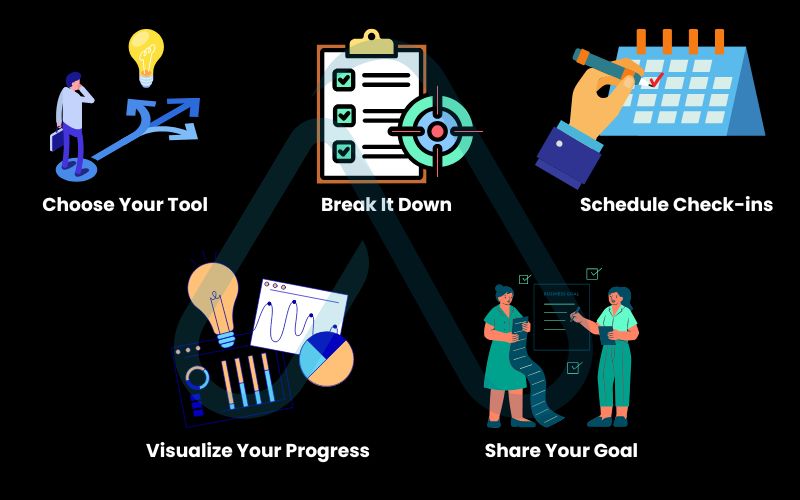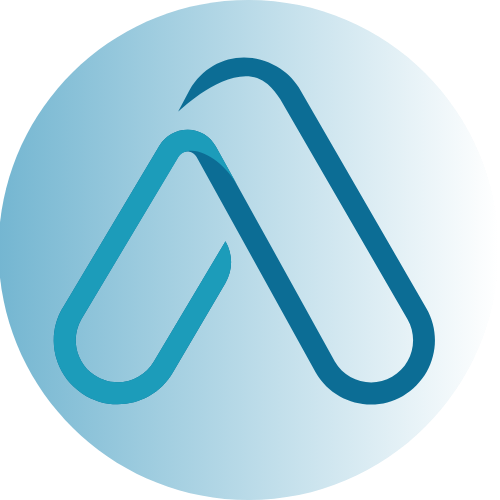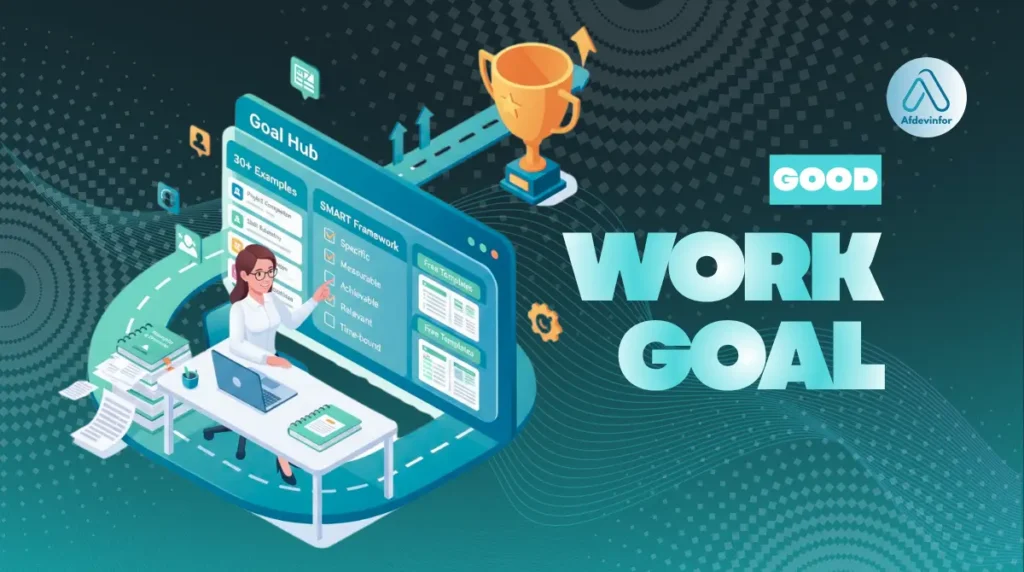When your annual review is coming up and that blank ‘goals’ section is staring back at you, it’s easy to feel stuck. I’ve been there. The question of what is a good work goal is more than just filling a box; it’s about drawing a map for your career. It’s the difference between being busy and being effective.
For over5 years, I’ve helped people move past vague to-do lists and into strategic goal-setting that delivers real, measurable impact. This guide is my playbook, designed to give you the clarity and tools you need to do the same.
Here’s what I’ll walk you through:
- Download my free templates to track your progress and prove your ROI.
- Discover 30+ actionable goal examples you can adapt for your role.
- Learn the simple frameworks, like SMART, that turn ideas into plans.
1. Why setting the right goals at work is your career superpower
Setting the right goals is one of the most powerful, yet underrated, skills you can develop in your professional life. It transforms your daily work from a series of disconnected tasks into a focused journey toward a destination you’ve chosen. A strategic goal isn’t just ‘do more work’; it’s a specific target that propels your career forward.
I’ve seen firsthand how effective goal-setting unlocks huge benefits. It provides:
- Clarity & Focus: Goals act as a compass, guiding your decisions and helping you prioritize what truly matters, cutting through the noise of daily tasks.
- Motivation & Engagement: Having a clear target to aim for provides a powerful source of intrinsic motivation, making your work more meaningful and satisfying.
- Skill Growth: The best performance goals at work push you out of your comfort zone, forcing you to learn new skills and strengthen existing ones.
- Demonstrable Impact: Well-defined goals allow you to track your progress and showcase your achievements with concrete data, which is invaluable during performance reviews and promotion discussions. These become your career development objectives.
1.1. The ‘bad goal’ trap: A quick-reference comparison
To really understand what makes a goal effective, it helps to see what a ‘bad’ goal looks like. I created this quick comparison table to illustrate the common traps many of us fall into and how to fix them, turning vague wishes into measurable goals for work.
| Bad Goal Example | Why It’s Ineffective | Good Goal (Fixed) |
|---|---|---|
| Get better at public speaking | It’s vague. There is no way to measure ‘better’ and no deadline. | Join a local Toastmasters club and deliver three prepared speeches over the next three months to improve my confidence and delivery skills. |
| Increase sales | This lacks specificity and a time frame. By how much? By when? | Increase my qualified sales leads by 15% in Q3 by implementing a new social media outreach strategy. |
| Learn to code | This is too broad. ‘Coding’ encompasses dozens of languages and disciplines. | Complete Codecademy’s ‘Introduction to Python’ course and build a small personal project (e.g., a weather app) within the next 90 days. |
| Be more organized | This is a subjective trait, not a measurable outcome. | Implement the Getting Things Done (GTD) methodology for my email and task management, reducing my unread inbox to zero by the end of each day for one month. |
2. How to set effective goals: Frameworks that actually work
Once you understand the ‘why,’ the next step is the ‘how.’ Instead of reinventing the wheel, I rely on proven goal-setting frameworks that provide structure and clarity. These systems are designed to force you to think through every aspect of your goal, ensuring it’s well-defined and achievable.
While there are several systems out there, such as OKRs (Objectives and Key Results), which are fantastic for teams, my go-to recommendation for individual SMART goals for employees is the S.M.A.R.T. framework. It’s simple, memorable, and incredibly effective at transforming a fuzzy idea into a concrete action plan.
2.1. The SMART goal deep dive: Your step-by-step guide
Let’s take the common, vague goal of ‘Improve marketing skills’ and walk it through the SMART framework step-by-step. This process is exactly how I refine my own professional objectives.
- Specific: Your goal must be clear and unambiguous. Ask yourself: What exactly do I want to accomplish? Who is involved? Why is this important? Instead of ‘Improve marketing skills,’ a more specific goal is: ‘I want to become proficient in Google Analytics 4 to better track our campaign performance.’
- Measurable: You need to be able to track your progress. Ask: How much? How many? How will I know when it is accomplished? Our goal becomes: ‘I will complete the official Google Analytics 4 certification course.’
- Achievable: Your goal should be realistic given your current resources and constraints. Ask: Do I have the skills and time to achieve this? Is it within my control? ‘I will dedicate 3 hours per week to studying, which is manageable with my current workload.’
- Relevant: The goal must align with broader business objectives and your personal career path. Ask: Does this goal matter? Does it support my team’s needs? ‘This skill will help my team better measure marketing ROI, a key company objective this quarter.’
- Time-bound: Your goal needs a target date. A deadline creates urgency. Ask: When will this be completed? ‘I will complete the certification within the next 60 days.’
Putting it all together, our vague idea has become a powerful SMART goal: ‘To help the team better measure marketing ROI, I will dedicate 3 hours per week to complete the official Google Analytics 4 certification course within the next 60 days.’
3. What is a good work goal? 30+ actionable examples you can use today
I know that the best inspiration often comes from concrete examples. The best goals are always tailored to your specific role, industry, and career aspirations, but this list is designed to be a powerful starting point. I’ve categorized these examples of work goals to help you find the ones most relevant to you for setting professional goals.
3.1. Short-term goals (for the next 30-90 days)
These goals are designed to create momentum and deliver quick wins. Here are a few examples:
- Master a new piece of software relevant to your role (e.g., Asana, Salesforce, Figma).
- Read one industry-specific book per month and present a summary of key takeaways to my team.
- Identify and eliminate one major time-wasting activity in my daily workflow to reclaim 30 minutes per day.
- Successfully complete a small-scale project from start to finish, managing all milestones and communication.
- Build a professional relationship with one person from a different department to better understand cross-functional collaboration.
Case Study
I once coached Sarah, a junior marketer, who set a goal to master Google Analytics 4 in 60 days. This short-term focus not only gave her a new, valuable skill but directly led to a 15% improvement in our campaign tracking and earned her a key role on a major new project.

3.2. Long-term goals (for the next 6-12 months)
These are the bigger-picture objectives that align with significant career progression. Here are some ideas:
- Obtain a professional certification (e.g., PMP, Google Ads, AWS Certified Developer).
- Lead a project team of three or more people, taking responsibility for delegation, timelines, and final outcomes.
- Develop and implement a new process or system that increases departmental efficiency by 10%.
- Mentor a junior team member, holding bi-weekly check-ins to support their growth over six months.
- Successfully transition into a new role or take on a significant new area of responsibility within the company.
- Build a professional portfolio of my work to showcase my skills and accomplishments.
3.3. Goals customized by role and industry
Generic advice only goes so far. Here are more specific goal ideas tailored to different professions:
For Software Development:
- Reduce the average bug resolution time for my assigned tickets by 20% over the next quarter by improving my debugging process.
- Contribute to an open-source project by successfully merging at least two pull requests within the next six months.
- Learn a new programming language or framework (e.g., Rust, Svelte) and build a small application with it.
For Marketing:
- Grow organic traffic to the company blog by 25% over the next six months by implementing a new SEO content strategy.
- Increase the conversion rate of our primary landing page by 15% through A/B testing headlines, copy, and CTAs.
- Launch and manage a lead-nurturing email campaign that generates 50 qualified leads in Q4.
For Project Management:
- Improve project delivery time by 10% by implementing a new agile methodology for my team within the next quarter.
- Achieve and maintain a project budget variance of less than 5% for all my projects in the next fiscal year.
- Conduct a post-mortem for every completed project and create a shareable ‘lessons learned’ document to improve future work.
3.4. Goals for developing soft and hard skills
Your growth depends on developing a mix of interpersonal and technical abilities. Here are goals for both:
Soft Skills:
- Improve active listening skills by summarizing the other person’s key points before responding in all team meetings for one month.
- Proactively ask for feedback from my manager and one peer after every major presentation to identify areas for improvement in communication.
- Take a course on conflict resolution and apply one new technique during a challenging team discussion.
Hard Skills:
- Become proficient in advanced Microsoft Excel functions (e.g., PivotTables, VLOOKUP) by completing an online course and applying them to my next monthly report.
- Learn the fundamentals of SQL to be able to pull and analyze my own data without relying on the analytics team.
- Gain foundational knowledge of a cloud platform like AWS or Azure by completing the introductory learning path.

4. Get your personalized goal suggestions
Sometimes, even with examples, it’s hard to know where to start. To help you bridge that gap, I’ve designed a simple tool to kickstart your brainstorming process.
Still not sure where to start? Answer three simple questions below to get a customized goal suggestion based on your role and priorities. This tool is my way of providing a personalized consultation, helping you with setting professional goals that are perfectly suited for your specific needs.
5. Don’t just set goals, measure them: How to track your success
A goal without a tracking plan is just a wish. From my experience, the act of tracking is what keeps you accountable and motivated. It’s not about bureaucracy; it’s about creating a feedback loop that shows you’re making progress. This is the ‘Return on Investment’ part of your effort—proving that your work is having a tangible impact.
Here are the simple steps I follow to track my own goals:
- Choose Your Tool: This can be a simple spreadsheet, a Notion page, a physical notebook, or one of the templates I provide below. The best tool is the one you’ll actually use.
- Break It Down: Deconstruct your main goal into smaller, weekly or monthly milestones. This makes the goal less intimidating and provides regular opportunities for small wins.
- Schedule Check-ins: Put a recurring 15-minute appointment on your calendar every Friday to review your progress. Did you hit your milestone? What went well? What obstacles did you face?
- Visualize Your Progress: Use a simple progress bar, a checklist, or a percentage complete. Seeing your progress visually is a powerful motivator.
- Share Your Goal: Tell your manager or a trusted colleague. This external accountability can provide the extra push you need to stay on track.

5.1. Simple KPIs and milestones to watch
KPI stands for Key Performance Indicator. It sounds corporate, but it’s just a simple metric to tell you if you’re on the right track. Here is a table to demystify it with practical examples.
| Goal Type | Example KPI/Milestone |
|---|---|
| Skill Acquisition | Chapters of a course completed; certification exam score; a functioning project built with the new skill. |
| Efficiency Improvement | Time saved per week (in hours); number of manual steps automated; reduction in error rate. |
| Project Management | Percentage of milestones completed on time; project budget adherence (e.g., within 5% of budget). |
| Networking/Relationship Building | Number of new contacts made per month; number of cross-departmental meetings initiated. |
5.2. Your free goal-tracking templates
To make tracking as easy as possible, I’ve created a few simple templates. There’s no need to start from scratch. Just pick the format that works best for you and get started.
- Download for Google Sheets: My Google Sheets template includes columns for your goal, key milestones, start/end dates, and a dynamic progress bar that updates automatically.
- Duplicate in Notion: For Notion users, this template provides a clean database view to track multiple goals, their status (Not Started, In Progress, Complete), and any related notes or files.
- Printable PDF: For those who prefer pen and paper, this simple, one-page PDF is perfect for printing out and keeping on your desk.
6. FAQs about what is a good work goal?
Here are answers to some of the most common questions I get about setting effective work goals.
What is the difference between a work goal and a personal goal?
Work goals are tied to your professional responsibilities and career, while personal goals relate to your private life, like hobbies or health.
What makes a work goal achievable?
An achievable goal is realistic, within your control, and supported by the necessary time and resources; break big goals into smaller steps.
How many goals should I set at once?
Focus on quality over quantity; aim for 1-3 major goals per quarter to ensure meaningful progress.
7. Final thoughts
Setting effective work goals is the single most impactful thing you can do to take control of your career trajectory. It moves you from a passive passenger to an active driver of your professional journey. I’ve built my own career on this principle, and I know it can work for you, too.
Here are the most critical takeaways I want you to remember:
- A good goal is more than a task; it’s a specific, measurable, and time-bound objective that aligns with your career aspirations.
- Frameworks like SMART are not just corporate jargon; they are powerful tools to bring clarity and structure to your ambitions.
- Tracking your progress is non-negotiable. It provides motivation and creates the evidence you need to demonstrate your impact.
- The best goals are personalized. Use the examples here as a starting point, but always tailor them to your unique situation.
A good goal is a map to the career you want. I encourage you to use the tools and examples in this guide to start drawing your map today. For more in-depth guides on professional development and productivity, explore our Career Development categories here on Afdevinfo.
Glossary of key terms
| Abbreviation | Full Term | Meaning |
|---|---|---|
| SMART | Specific, Measurable, Achievable, Relevant, Time-bound | A framework used to create clear, actionable, and trackable goals. |
| OKR | Objectives and Key Results | A goal-setting methodology that links ambitious company and team goals to measurable results. |
| KPI | Key Performance Indicator | A quantifiable measure used to evaluate the success of an individual, team, or organization in meeting objectives. |
| ROI | Return on Investment | A performance measure used to evaluate the benefit from an investment. In this context, it’s the professional benefit gained from the effort put into achieving a goal. |


